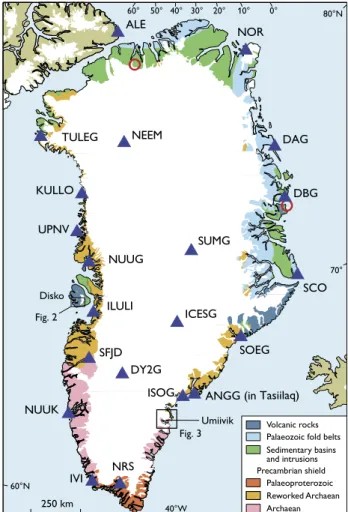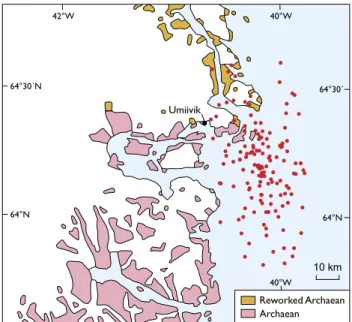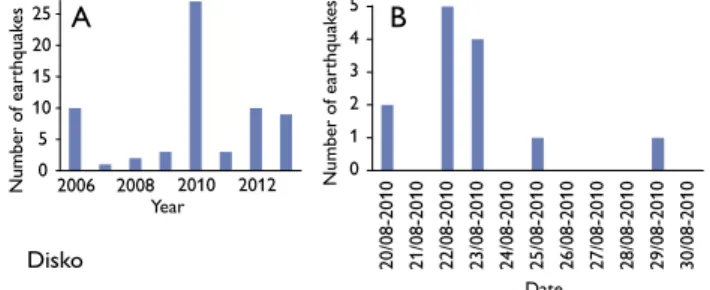75
Earthquake swarms in Greenland
Tine B. Larsen, Peter H. Voss, Trine Dahl-Jensen and Hans Peter Rasmussen
Two earthquake swarms have been detected in Greenland. One occurred on the island of Disko in August 2010, the other one was active from January 2008 to June 2009 near
the South-East Greenland coast c. 200 km south of Tasiilaq.
An earthquake swarm is deined as a series of earthquakes of similar magnitude located within a small area. he mag-nitude of the largest earthquakes in a swarm is typically less than 4 (Ma & Eaton 2009). Swarm activity is distinctly dif-ferent from the more common mainshock–atershock activ-ity, which is characterised by one large earthquake (main-shock) followed by a series of smaller atershocks. Earthquake swarms mainly occur in areas with tectonic and/or volcanic activity (Stykes 1970), but intraplate swarms are also found in otherwise stable environments (Gregersen 1979; Atakan
et al. 1994; Uski et al. 2006; Ma & Eaton 2009). Geological boundaries and old fault zones appear to be a common set-ting for intraplate earthquake swarms. Earthquake swarms have previously been detected in North and North-East Greenland (Gregersen 1979) at a time when the seismograph coverage was very sparse. It was concluded that the earth-quake swarms were caused by tectonic stresses in and around old sedimentary basins near the continental margin.
In this study we take advantage of the recently improved network of digital broadband seismographs in Greenland
(Dahl-Jensen et al. 2010). he shorter distance between
seis-mograph stations and the high quality digital data enable us to better detect small earthquakes. We have focused on the last decade during which the digital network has gradually been established (Fig. 1). We revisited the two regions where swarms have previously been detected, in North Greenland and in North-East Greenland (Gregersen 1979). Search-ing the GEUS earthquake database for recent earthquakes showed nothing in the area of the North Greenland swarm. he swarm described by Gregersen (1979) was primarily detected using data from a Canadian station (ALE) and a temporary station on the ice sheet, supplemented with data from Station Nord (NOR) for the largest earthquakes in the swarm. his particular region has not experienced an increase in station coverage in recent years. It is therefore impossible to distinguish whether the lack of recent detec-tions is due to a lack of activity in that area. he location of the North-East Greenland earthquake swarm has also been searched without inding any new swarm activity in the last
decade. Only two small earthquakes have been detected in the area, one in 2008 and another in 2011. In this area the station coverage has improved since 1974, so the lack of de-tections relects that the area is currently seismically quiet.
Two new localities with earthquake swarms were uncov-ered in this study (Fig. 1). Both are areas with regular seismic activity. One swarm is located on the island of Disko near the Disko Gneiss Ridge (Fig. 2) where a fault zone runs N–S
through the island (Chalmers et al. 1999). his is a very
dis-tinct swarm with its main activity concentrated on two days
© 2014 GEUS. Geological Survey of Denmark and Greenland Bulletin 31, 75–78. Open access: www.geus.dk/publications/bull
DAG
SCO
SFJD
NRS NUUK
SUMG
ANGG (in Tasiilaq) DY2G
DBG
SOEG NOR ALE
ILULI KULLO
TULEG
ISOG
IVI
NUUG
ICESG UPNV
Fig. 2
Fig. 3
250 km
60°N
60° 50° 40° 30° 20° 10° 0°
40°W
80°N
70°
Disko
Umiivik
Archaean Volcanic rocks Palaeozoic fold belts Sedimentary basins and intrusions
Reworked Archaean Palaeoproterozoic Precambrian shield
NEEM
76 76
in late August 2010, followed by slightly increased seismicity during the following two months. he other swarm is loc-ated in a remote area near the South-East Greenland coast,
c. 200 km south of Tasiilaq (Fig. 3). his swarm is less
dis-tinct with two main pulses of activity in January 2008 and spring 2009. his area had increased seismicity for a year and a half, before it tapered of. he objective of this paper is to describe the two newly discovered earthquake swarms and how they relate to the local geology.
Data and analysis
Seismographs have been continuously operating in Green-land since 1927 (Hjelme 1996). Originally the instruments were large, diicult to install and labour intensive to main-tain. It was only possible to operate a few stations in Green-land. his changed with the development of digital instru-ments, and during the last decade a network of 20 digital broadband seismographs with real-time data transmission has been installed in Greenland (Fig. 1). his massive un-dertaking is a result of the international collaboration in the Greenland Ice Sheet Monitoring Network (GLISN) project with funding from around the world (Dahl-Jensen
et al. 2010). he latest seismological station was installed in Upernavik in 2013 by the Korean Polar Research Institute (see UPNV Fig. 1).
Data from the real-time network of seismographs are processed daily at GEUS using the SEISAN analysis
sot-ware (Ottemöller et al. 2013). Earthquake phases are
manu-ally identiied and combined to form earthquake locations when possible. Locations and phase readings are kept in the GEUS database for future reference. his includes phase readings not associated with an earthquake location. All the raw waveform data are also stored. he new earthquake
swarms were discovered by performing a search in the da-tabase around locations, where clustering of seismicity was observed on a map of all earthquakes in Greenland. he search results were then examined for possible clustering of events in time. Two earthquake clusters fulilled the criteria deining an earthquake swarm. Despite the improved sta-tion coverage, it is still challenging to determine the focal mechanism of most earthquakes in Greenland. Particularly the small swarm earthquakes that are only registered on one to four seismographs, which is insuicient for reliable focal mechanism calculations.
Earthquake swarm at the island of Disko
Disko and the surrounding areas are frequently shaken by small earthquakes, some large enough to be felt by the locals. Disko is also known for its warm springs formed where circu-lating surface water penetrates into the subsurface through deep cracks and is heated by the higher temperatures at depth. he low of a warm spring is sometimes changed by a small earthquake, indicating that the earthquake sources are shallow. here are thousands of springs with constant tem-perature on Disko. he temtem-peratures in individual springs vary between 1°C and 18.5°C (Kristensen 2006).
he number of earthquakes detected near the southern end of the Disko Gneiss Ridge per year for 2006–2013 var-ies between one and ten (Fig 4A). However, 2010 stands out with 27 detected earthquakes. he earthquake activity was particularly intense on 22 and 23 August (Fig 4B). he earthquakes ranged in magnitude from 1.9 to 3.2 with most
Lower Tertiary basalts Upper Cretaceous and lower
Precambrian basement Tertiary sediments
Fault
10 km
69°30´
Storbræen
Disko Fjord
55°W
Fig. 2. The calculated epicentres for the swarm earthquakes on Disko, West Greenland. The Disko Gneiss Ridge runs along the fault line on the map.
Reworked Archaean Archaean
64°30´
10 km
Umiivik
42°W
64°N 64°30´N
64°N 40°W
40°W
77
clustering in the magnitude range between 2.2 and 2.8. he earthquake epicentres were spread out over a small area with the largest distance between two events being about 30 km. his distance is within the uncertainty on the locations. he uncertainty on the epicentres is in the order of 10 km in N–S direction and at least 50 km in E–W direction. his is caused by the geometry of the network relative to the events with seismographs primarily located north and south of the epicentres. As Fig. 2 shows, the scatter in the epicentres was indeed largest in E–W direction.
he closest seismograph where all earthquakes were regis-tered is located in Ilulissat (ILULI) 110–120 km away. he earthquakes were also registered in Nuugaatsiaq (NUUG)
c. 220 km to the north, in Kangerlussuaq (SFJD) 320 km
to the south and at the Summit ice camp (SUMG) 650 km towards the north-east. A few earthquakes were registered on a total of eight seismographs in Greenland, but most of them were registered in just four locations. he depth of the earthquakes is poorly determined, but appears to be shallow. A major challenge in determining the depth is the limited knowledge of the crustal velocity structure. he depth to Moho is known from receiver function studies (Dahl-Jensen
et al. 2003), and the crustal density structure in the Disko area has been modelled from seismic and potential ield data
(Chalmers et al. 1999). Relocating the earthquakes with a
ixed depth of 5 km does not reduce the distance between the epicentres signiicantly. However, the variation in time
diference between the P-wave arrival and the S-wave arrival
was less than 1.5 sec. indicating a small source region. he north–south-oriented fault along the Disko Gneiss Ridge is a known zone of weakness, and the area is charac-terised by a moderate earthquake activity with no seasonal variation. In SE Finland earthquake swarms are observed to be related to the intrusion of water and gas into
frac-tures working in concert with the local stress ield (Uski et
al. 2006). A similar mechanism is likely on Disko. As warm
water is circulating in deep cracks all year round a seasonal variation is not expected. Some of the warm springs on Disko
are radioactive (Kristensen 2006) containing radon from the basement. Radon is also observed near earthquake swarms in Finland, and radon gas is believed to play a minor role in
trig-gering earthquake swarms in SE Finland (Uski et al. 2006).
Earthquake swarm in South-East
Greenland
he east coast of Greenland is frequently shaken by small earthquakes. In Tasiilaq earthquakes are felt almost every year. Many small earthquakes are registered farther down the coast, but it is not known if any of these events can be felt as the area is not populated. Earthquake swarm activity was detected in January 2008 and in the spring of 2009 just of the coast near Umiivik. he earthquakes in the swarm range in magnitude from 1.8 to 3.8. In the years before and ater the swarm period, the level of earthquake activity in the area range between 12 and 21 earthquakes per year (Fig. 5A). However, in 2008 and 2009 respectively 71 and 114 earth-quakes were registered. he earthearth-quakes occurred primarily in January and April 2008 and again from January to July 2009 (Fig. 5B).
he uncertainty on most of the epicentres is several hun-dred kilometres in both the N–S and E–W directions. his is a consequence of the earthquakes being detected primarily by only two seismographs (four phases in total) in Kangerlus-suaq (SFJD) and at Summit (SUMG) 550 km and 1000 km from the epicentres. he distance between the seismographs and the epicentres is well-determined, but the direction is poorly constrained. Ater improvements had been made to the seismograph network, a larger earthquake with a mag-nitude of 3.6 occurred in the area on 13 October 2009. his earthquake was well-recorded at four locations: Narsarsuaq (NRS), Kangerlussuaq (SFJD), Ilulissat (ILULI) and Sum-mit (SUMG) with an uncertainty of less than 10 km in N–S direction and less than 20 km in E–W direction. his
earth-Fig. 5. A: Number of earthquakes per year for the period 2006–2013 around the location of the earthquake swarm at the SE Greenland coast. B: Number of earthquakes per month from January 2008 to July 2009 in the same area.
0 1 2 3 4 5 20 /0 8-20 10 21 /0 8-20 10 22 /0 8-20 10 23 /0 8-20 10 24 /0 8-20 10 25 /0 8-20 10 26 /0 8-20 10 27 /0 8-20 10 28 /0 8-20 10 29 /0 8-20 10 30 /0 8-20 10 0 5 10 15 20 25
2006 2008 2010 2012 Year
Date
Number of ea
rt
hqua
ke
s
Number of ea
rt hqua ke s A B Disko
Fig. 4. A: Number of earthquakes per year for the period 2006–2013 around the location of the earthquake swarm on Disko. B: Number of earthquakes per day from 20 to 30 August 2010 in the same area.
Jan Mar Ma Jan
y Ju l Sep No v Mar Ma y Ju l
2006 2008 2010 2012 Year
Month (2008 and 2009)
Number of ea
rt
hqua
ke
s
Number of ea
78 78
quake is located near the centre of the cloud of epicentres, and it can be used to evaluate the relative locations of the swarm earthquakes.
he waveforms for the small earthquakes are very noisy, making a direct comparison diicult. Instead we examine
the variation in time diference between the P-wave and S
-wave arrival for individual earthquakes. Despite the epicen-tres being scattered over almost 100 km in N–S direction
and c. 50 km in E–W direction, the variation in S–P time
(i.e. the distance to the earthquake) at each seismograph sta-tion luctuated only in rare cases by more than 1.5 sec. rela-tive to the 13 October 2009 earthquake. he large scatter in epicentres is probably an artefact of the focal depth being unconstrained.
he Umiivik area marks a major geological transition be-tween the relatively unreworked Archaean rocks to the south and rocks highly deformed in the Proterozoic to the north
(Henriksen et al. 2009). Ofshore the existence of a failed rit
arm was proposed by Hopper et al. (1998). he earthquake
swarm was thus located close to two old geological bounda-ries. his is in good accordance with the general observations by Stykes (1978) that intraplate earthquakes indeed occur in old zones of weakness.
Conclusion
As shown by this initial search for earthquake swarms, the improvements to the seismograph network in Greenland enable us to better uncover and analyse swarms in the fu-ture. he swarms presented in this paper could not have been detected a decade ago. Intraplate earthquake swarms can contribute to the understanding of geological processes currently at work near old geological boundaries in remote areas. Both swarms presented here were active near old geo-logical boundaries. he swarm on Disko is located at the southern end of the Disko Gneiss Ridge where a large fault runs through the island. Circulating water in deep cracks may possibly play a role. he SE Greenland swarm is located close to a major geological boundary between reworked and unreworked Archaean rocks. Furthermore, the swarm is close to the proposed location of a failed rit arm in the At-lantic. Finding earthquake swarms close to old, major, geo-logical boundaries is well in accordance with the literature. he earthquake swarms presented in this paper are not as-sociated with known sedimentary basins such as the swarms described in Gregersen (1979). his indicates a diversity of
swarm sources in Greenland. Further work will be carried out on the earthquake swarms in Greenland and data from temporary and Canadian seismographs will be included in the analysis.
Acknowledgement
he data were collected and distributed by the GLISN project and its members, www.glisn.info.
References
Atakan, K., Lindblom, C.D. & Havskov, J. 1994: Earthquake swarm in Steigen, northern Norway: an unusual example of intraplate seismicity. Terra Nova 6, 180–194.
Chalmers, J.A., Pulvertat, T.C.R., Marcussen, C. & Pedersen, A.K. 1999: New insight into the structure of the Nuussuaq Basin, central West Greenland. Marine and Petroleum Geology 16, 197–224.
Dahl-Jensen, T. et al. 2003: Depth to Moho in Greenland: receiver func-tion analysis suggests two Proterozoic blocks in Greenland. Earth and Planetary Science Letters 205, 379–393.
Dahl-Jensen, T., Larsen, T.B., Voss, P.H. & the GLISN group 2010: Green-land ice sheet monitoring network (GLISN): a seismological approach. Geological Survey of Denmark and Greenland Bulletin 20, 55–58. Gregersen, S. 1979: Intraplate earthquake swarms in Greenland and
adja-cent continental regions. Nature 281, 661–662.
Henriksen, N., Higgins, A.K., Kalsbeek, F. & Pulvertat, T.C.R. 2009: Greenland from Archaean to Quaternary. Descriptive text to the Geo-logical map of Greenland 1:2 500 000. 2nd edition. Geology of Green-land Survey Bulletin 18, 126 pp.
Hjelme, J. 1996: History of seismological stations in Denmark and Green-land. In: Wahlström, R. (ed.): Seismograph recording in Sweden, Nor-way – with arctic regions, Denmark – with Greenland, and Finland. Proceedings from the Uppsala Wiechert Jubilee Seminar, 49–57. Upp-sala: Seismological Department, Uppsala University, Sweden. Hopper, J.R., Lizarralde, D. & Larsen, H.C. 1998: Seismic investigations
ofshore South-East Greenland. Geology of Greenland Survey Bulletin 180, 145–151.
Kristensen, R.M. 2006: De varme kilder. In: Bruun, L. et al. (eds): Arktisk Station 1906–2006, 310–315. Copenhagen: Rhodos.
Ma, S. & Eaton, D.W. 2009: Anatomy of a small earthquake swarm in southern Ontario, Canada. Seismological Research Letters 80, 214– 223, http://dx.doi.org/10.1785/gssrl.80.2.214
Ottemöller, L., Voss, P.H. & Havskov, J. 2011: SeisAn earthquake analy-sis sotware for Windows, Solaris, Linux and MacOSX. University of Bergen.
Stykes, L.R. 1970: Earthquake swarms and sea-loor spreading. Journal of Geophysical Research 75, 6598–6611.
Stykes, L.R. 1978: Intraplate seismicity, reactivation of pre-existing zones of weakness, alkaline magmatism, and other tectonism postdating con-tinental fragmentation. Reviews of Geophysics and Space Physics 16, 621–688.
Uski, M., Tiira, T., Korja, A. & Elo, S. 2006: he 2003 earthquake swarm in Anjalankoski, south-eastern Finland. Tectonophysics 422, 55–69.
Authors’ address


